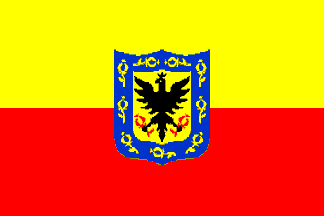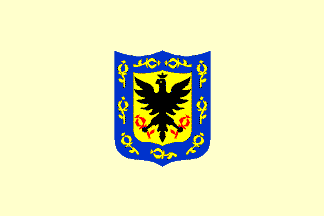Bogota (Distrito Capital, Colombia) (original) (raw)

This page is part of © FOTW Flags Of The World website
Santafé de Bogotá, Capital District
Last modified: 2021-08-26 by  klaus-michael schneider
klaus-michael schneider
Keywords: bogota | colombia | [santafe de bogota](keywords.html#santafe de bogota) | [distrito capital](keywordd.html#distrito capital) |
Links: FOTW homepage |search | disclaimer and copyright | write us | mirrors
- The Flag
- Flag with Coat of Arms
- Additional Flag of Bogotá
- Coat of Arms
- Bogotá Mayor Sash
- Personería de Bogotá D.C.
- Empresa de Acueducto y Alcantarillado de Bogotá
See also:
- Colombia
- Bogotá Mayorship flag
- Contralor�a de Bogot� (Comptroller of Bogot�)
- Cundinamarca Independent State (1813-1814)
- Clickable map of Colombia
- Colombia - Departamentos and Distrito Capital
- Educational Institutions
Municipalities (Localidad):
- [1] Usaquén
- [2] Chapinero
- [3] Santa Fé
- [4] San Cristobal
- [5] Usme
- [6] Tunjuelito
- [7] Bosa
- [8] Kennedy
- [9] Fontibón
- [10] Engativá
- [11] Suba
- [12] Barrios Unidos
- [13] Teusaquillo
- [14] Martirés
- [15] Antonio Nariño
- [16] Puente Aranda
- [17] La Candelaria
- [18] Rafael Uribe Uribe
- [19] Ciudad Bolivar
- [20] Sumapaz
Other Sites:
The Flag
Adopted: 1952, colours based on the flag of the revolt of 1810. See: Cundinamarca Independent State (1813-1814).
Jaume Olle, 8 September 1996
At <www.udistrital.edu.co> there is more info about the flag. The image is plain yellow over red bicolor.
Dov Gutterman, 27 December 1998
According to the official site the flag is plain yellow over red without the Coat of Arms. The site says:
"La Bandera de Bogotá halla su origen en el mismo movimiento de, insurgencia contra las autoridades coloniales que estalló el 20 de julio de 1810. Los rebeldes comenzaron a llevar ese día en el antebrazo una escarapela con los colores amarillo y rojo, que son los de la Bandera de España vigente entonces para el Nuevo Reino de Granada. Después de 142 años, mediante decreto 555 del 9 de octubre de 1952, la escarapela patriota quedó oficial y definitivamente adoptada como Bandera de Bogotá.
Elevado y ejemplar es el significado atribuido a los colores de la Bandera. El amarillo se toma por representativo de la justicia, clemencia, virtud y benignidad y el rojo por símbolo de libertad, salud y caridad. Se trata de cualidades que se desean ver reflejadas en el comportamiento personal y colectivo de todos los habitantes de Santa Fe de Bogotá."
Source: <www.alcaldiabogota.gov.co>.
Dov Gutterman, 12 May 2002
Flag with Coat of Arms

by Carlos Thompson, 22 March 2003
Additional Flag of Bogotá

image by Zoltan Horvath, 24 November 2013
On November 15, during a tv news broadcast by CM& one can see an additional official flag of Bogotá. It is a plain horizontal white flag with the coat of arms in the middle.
Image (official flag is the first from left to right).
Esteban Rivera, 19 November 2013
This flag seems not to be white, but pale yellow or cream. Please see board backround, and jackets wearing by guys around the table. They are white. If you compare the colour shade of flag with these white elements on this picture, we can state that this flag is definitley not white. This flag may not belong to Bogotá itself, likely it belongs to a department or other entity of Mayor administration.
Zoltan Horvath, 24 November 2013
Coat of Arms

by Carlos Thompson, 22 March 2003
Distrito Capital (Bogotá) adopted the Coat of Arms at the Real cédula dada en Valladolid on 3 December 1548, ten year after the fundation of the city_._ Luis Carrillo, 15 July 2002
The crowned eagle is because we were under the government of Spain, I think that is what it represent. About the flowers that the coat of arms has, it is the grenade flower, that's because Colombia, as you know, was named Nueva
Granada (New Grenade). The Colors are red and yellow because it was a Spanish colony.
Juan Arenas, 31 March 2004
The correct name of "granda" in English is "pomegranate". The Latin name of the pomegranate tree is "Punica granatum". "Punica" recalls that the tree was brought back from Carthago by the Romans. In French, the ancient name of the fruit was "pume grenate", "pume" being an ancient form of "pomme" (apple) and "grenate" derived from Latin "granatum", a fruit with grains, via a dialect of Northern Italia (Grand Robert de la Langue Francaise). The name of the fruit was later simplified to "grenade", the same word being later used for the weapon. In the ancient mythology, the grain of pomegranate was the symbol of the faults and pleasures which sent you to hell. It was later adopted as the mystical symbol of divine perfection (op. cit.).
Ivan Sache, 1 April 2004
Bogotá Mayor Sash
Today during the inauguration of the Mayor of the City of Bogotá, one can see the sash, which has the same colors as the flag and also the Coat of Arms.
The sash can be seen here:
- Picture:http://www.elespectador.com/files/images/201201/b0fcdb13b2f4da9b324ead95ffcbb7ca.jpg
(Source:http://www.elespectador.com/noticias/bogota/imagen-319212-gustavo-francisco-petro-alcalde-de-bogota)
- Video:http://www.eltiempo.com/colombia/bogota/posesion-de-gustavo-petro-alcalde-de-bogota_10931227-4
Esteban Rivera, 02 January 2012
Personería de Bogotá D.C.
Empresa de Acueducto y Alcantarillado de Bogotá

image located by Esteban Rivera, 14 December 2015
